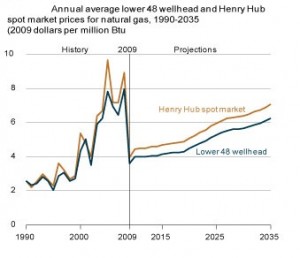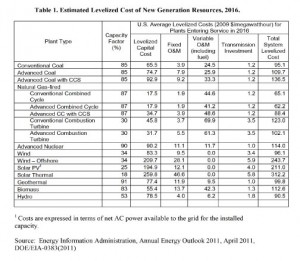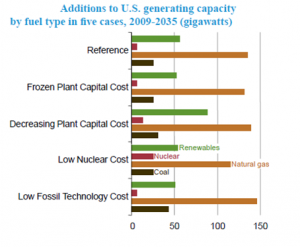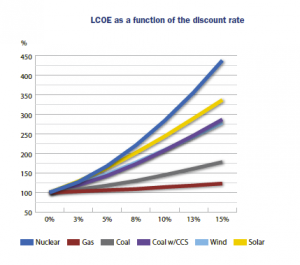Are gas prices too low – or nuclear costs too high? Or a bit of both??
John Rowe, Chairman and CEO of Exelon (August 15, 2011)
In his speech to the American Nuclear Society Utility Working Conference in Hollywood, Fla. entitled “My Last Nuclear Speech”, Rowe, while accepting that nuclear is an important option to meet climate change and other policy objectives; states very matter of factly that nuclear is not competitive at this time in the US. And given this statement is coming from the CEO of America’s largest nuclear utility, it is important to pay attention.
In his talk, he refers to four conditions he laid out twenty years ago for nuclear success:
- the right reactor technology with passive designs;
- a workable solution to the waste problem;
- a need for new generation; and
- a shortage of natural gas and stable high prices to make the economics right
It is this last condition that is the big issue today due to a huge increase of shale gas into the US market. Shale gas is good for the country, but bad for new nuclear development as it has resulted in low gas prices thus having a significant impact on nuclear competitiveness.
And indeed they are low. In the EIA’s Annual Energy Outlook (AEO 2011), the assumption is that gas prices stay below $5/million Btu until 2020, below $6/ million Btu until 2025 and then below $7/ million Btu until 2035. Prices far below the peak of almost $10/ million Btu reached before 2009.
Source: AEO 2011
While low gas prices present a major challenge, we cannot control gas prices, so we in the industry must focus on what we can control – and that is the cost of building new nuclear units. In my blog of last December, I discussed the widening gap of nuclear capital costs between east and west noting that the cost of new nuclear plants is trending to less than $2,000 /kW in China while now higher than $5,000 /kW in the US. Since that time the EIA’s Annual Energy Outlook (AEO 2011) was issued and the impact of higher cost assumptions on new nuclear is very evident. The reference case only has five new nuclear units in the US. Watts Bar will be completed at TVA and four new units will be built to take advantage of government incentives.
The reason for this base case is clear. With its current assumptions on costs, nuclear cannot compete with gas. And the issue is really a combination of two assumptions – first the ongoing low cost of gas and second, a relatively high capital cost for nuclear. The following table has been published by the US government in its AEO 2011. The results are stark with new advanced nuclear costing 80% more than new advanced combined cycle gas plants. Now given the assumptions, these results are not too surprising but, none-the-less, they point to a very real issue for nuclear in the US going forward. And the nuclear assumptions do appear reasonable so while varying the assumptions can make improvements, there is a large gap to close.
However, the news is not all bad. A sensitivity case assuming that lower nuclear plant costs can be achieved does indeed show more nuclear in America’s future. In the EIA Low Nuclear Cost Scenario, the assumption is that nuclear is 20% less cost today and continues to decline until its cost is 40% less in 2035. This translates into a drop from about $5,400 /kW as the base case assumption to about $3,200/kW, a very reasonable and sensible target. In this scenario, new nuclear plants do get built with more units as the price declines in the outer years.
Source: AEO 2011
This brings nuclear into the range of gas costs and given a change of some other assumptions it has the potential to be very competitive. First of all, if gas consumption does increase as projected and becomes the fuel of choice for America (as currently anticipated), and there are environmental difficulties adding cost to extracting shale gas, it is very reasonable to project somewhat higher gas prices. Keep in mind that even a short term price of $6 or $7/ million Btu will have a significant positive impact on the comparative economics.
And, from a policy perspective, a continuation of the loan guarantee program can be a very effective way to reduce the cost of nuclear. As seen below, nuclear power is extremely sensitive to the assumption on discount rate while gas is very insensitive (due to the capital intensity of nuclear versus the fuel intensity of gas). Therefore a loan guarantee that brings down the cost of capital will have a large beneficial impact to the competitiveness of nuclear.
Source: OECD/IEA Projected Cost of Electricity 2010 Edition
So what does this all mean? Going back to my comments in December, since waiting for gas prices to increase is not a viable strategy, then we must focus our efforts on reducing the capital cost of new nuclear units (Let’s get back below $4,000/kW and the discussion will change very quickly!).
And that means developing CONFIDENCE! And confidence comes from doing as we have seen with the booming Chinese program – major cost improvements due to learning by doing and series production of standardized designs. In the US, we see the opposite as costs continue to rise in an environment where securing commitments for new projects is moving very slowly.
So what should we (the industry) be doing? With US companies supplying technology and major components to projects in China, they are gaining experience in building in the most dynamic market in the world. The question then becomes, are we ready to really learn from this experience and take full advantage of it? We need to make use of the proven supply chain and experts from wherever it makes most sense, to the maximum extent possible. If a combination of Western (primarily American) and Chinese experts and equipment is what is succeeding in China, then we need to repeat this for projects in the west. Of course, the share will change as there will be more western content in a North American plant than in a Chinese plant, but we should not be afraid to make use of high quality low cost global supply to keep costs under control.
If we do, the price of nuclear power in the west will start to drop quickly and continue to improve and many new plants will be built. If we don’t, then we face the prospect of having to pay the price of relearning the lessons that have already been learned elsewhere and, as shown in the table above, we cannot afford this. For example, building 20 or 30 new US designed units with a somewhat lower domestic content at a competitive price creates ongoing opportunity for the industry versus one or two new units maximizing domestic content demonstrating poor economics. It is obvious which option creates the most sustainable jobs in the US for the long term.
So my conclusion stays the same as it was in December. Nuclear power can be an economic option for electricity generation. Now it is up to the industry in the west to ensure that lessons learned in Asia are applied quickly enough to ensure the competitiveness of planned projects and get the nuclear renaissance in the west back on track.
After all, Nuclear is a business, not a religion……
Note: A new study in Japan shows that even considering the costs of the Fukushima accident, nuclear is likely to be the most economic option for generating electricity relative to fossil fuels. This demonstrates that nuclear competitiveness can vary significantly from location to location as local conditions are taken into account.









1 Comment
Thad Simmons · September 10, 2011 at 6:27 am
Central to the reduced costs of the China projects is reduced regulatory costs, not necessarily process efficiencies (although that is also a big player). US plants are under such intense scrutiny that costs associated with oversight have skyrocketed. US NRC must set reasonable, clearly defined, set of expectations and then stick to them. Recent NRC hearings on the ITAAC process underline that NRC has not set clear expectations with the result being confusion by new plant licensees and constructors.
Comments are closed.